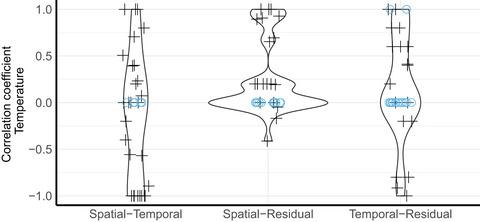当前位置:
X-MOL 学术
›
Glob. Change Biol.
›
论文详情
Our official English website, www.x-mol.net, welcomes your feedback! (Note: you will need to create a separate account there.)
Decomposing the spatial and temporal effects of climate on bird populations in northern European mountains
Global Change Biology ( IF 11.6 ) Pub Date : 2022-07-28 , DOI: 10.1111/gcb.16355 Ute Bradter 1 , Alison Johnston 2, 3 , Wesley M Hochachka 2 , Alaaeldin Soultan 4 , Jon E Brommer 5 , Elie Gaget 5, 6 , John Atle Kålås 1 , Aleksi Lehikoinen 7 , Åke Lindström 8 , Sirke Piirainen 7, 9 , Diego Pavón-Jordán 1 , Tomas Pärt 4 , Ingar Jostein Øien 10 , Brett K Sandercock 1
Global Change Biology ( IF 11.6 ) Pub Date : 2022-07-28 , DOI: 10.1111/gcb.16355 Ute Bradter 1 , Alison Johnston 2, 3 , Wesley M Hochachka 2 , Alaaeldin Soultan 4 , Jon E Brommer 5 , Elie Gaget 5, 6 , John Atle Kålås 1 , Aleksi Lehikoinen 7 , Åke Lindström 8 , Sirke Piirainen 7, 9 , Diego Pavón-Jordán 1 , Tomas Pärt 4 , Ingar Jostein Øien 10 , Brett K Sandercock 1
Affiliation

|
The relationships between species abundance or occurrence versus spatial variation in climate are commonly used in species distribution models to forecast future distributions. Under “space-for-time substitution”, the effects of climate variation on species are assumed to be equivalent in both space and time. Two unresolved issues of space-for-time substitution are the time period for species' responses and also the relative contributions of rapid- versus slow reactions in shaping spatial and temporal responses to climate change. To test the assumption of equivalence, we used a new approach of climate decomposition to separate variation in temperature and precipitation in Fennoscandia into spatial, temporal, and spatiotemporal components over a 23-year period (1996–2018). We compiled information on land cover, topography, and six components of climate for 1756 fixed route surveys, and we modeled annual counts of 39 bird species breeding in the mountains of Fennoscandia. Local abundance of breeding birds was associated with the spatial components of climate as expected, but the temporal and spatiotemporal climatic variation from the current and previous breeding seasons were also important. The directions of the effects of the three climate components differed within and among species, suggesting that species can respond both rapidly and slowly to climate variation and that the responses represent different ecological processes. Thus, the assumption of equivalent species' response to spatial and temporal variation in climate was seldom met in our study system. Consequently, for the majority of our species, space-for-time substitution may only be applicable once the slow species' responses to a changing climate have occurred, whereas forecasts for the near future need to accommodate the temporal components of climate variation. However, appropriate forecast horizons for space-for-time substitution are rarely considered and may be difficult to reliably identify. Accurately predicting change is challenging because multiple ecological processes affect species distributions at different temporal scales.
中文翻译:

分解气候对北欧山区鸟类种群的时空影响
物种丰度或发生率与气候空间变化之间的关系通常用于物种分布模型以预测未来分布。在“时空替代”下,假设气候变化对物种的影响在空间和时间上是等效的。空间换时间替代的两个未解决的问题是物种响应的时间段,以及快速反应与慢速反应在形成对气候变化的空间和时间响应方面的相对贡献。为了检验等效假设,我们使用了一种新的气候分解方法将 23 年期间(1996-2018 年)Fennoscandia 的温度和降水变化分为空间、时间和时空分量。我们为 1756 次固定路线调查收集了土地覆盖、地形和气候的六个组成部分的信息,并模拟了 Fennoscandia 山区 39 种鸟类的年度繁殖数量。正如预期的那样,当地繁殖鸟类的丰度与气候的空间成分有关,但当前和之前繁殖季节的时间和时空气候变化也很重要。三种气候成分的影响方向在物种内部和物种之间不同,这表明物种可以快速和缓慢地响应气候变化,并且响应代表不同的生态过程。因此,在我们的研究系统中很少满足等效物种对气候时空变化的反应的假设。因此,对于我们的大多数物种来说,空间换时间替代可能仅适用于慢速物种对气候变化的反应发生后,而近期的预测需要适应气候变化的时间成分。然而,很少考虑空间换时间替代的适当预测范围,并且可能难以可靠地识别。准确预测变化具有挑战性,因为多种生态过程会影响不同时间尺度的物种分布。空间换时间替代可能仅适用于慢速物种对气候变化做出反应的情况,而近期的预测需要考虑气候变化的时间成分。然而,很少考虑空间换时间替代的适当预测范围,并且可能难以可靠地识别。准确预测变化具有挑战性,因为多种生态过程会影响不同时间尺度的物种分布。空间换时间替代可能仅适用于缓慢物种对气候变化做出反应的情况,而近期的预测需要考虑气候变化的时间成分。然而,很少考虑空间换时间替代的适当预测范围,并且可能难以可靠地识别。准确预测变化具有挑战性,因为多种生态过程会影响不同时间尺度的物种分布。
更新日期:2022-07-28
中文翻译:

分解气候对北欧山区鸟类种群的时空影响
物种丰度或发生率与气候空间变化之间的关系通常用于物种分布模型以预测未来分布。在“时空替代”下,假设气候变化对物种的影响在空间和时间上是等效的。空间换时间替代的两个未解决的问题是物种响应的时间段,以及快速反应与慢速反应在形成对气候变化的空间和时间响应方面的相对贡献。为了检验等效假设,我们使用了一种新的气候分解方法将 23 年期间(1996-2018 年)Fennoscandia 的温度和降水变化分为空间、时间和时空分量。我们为 1756 次固定路线调查收集了土地覆盖、地形和气候的六个组成部分的信息,并模拟了 Fennoscandia 山区 39 种鸟类的年度繁殖数量。正如预期的那样,当地繁殖鸟类的丰度与气候的空间成分有关,但当前和之前繁殖季节的时间和时空气候变化也很重要。三种气候成分的影响方向在物种内部和物种之间不同,这表明物种可以快速和缓慢地响应气候变化,并且响应代表不同的生态过程。因此,在我们的研究系统中很少满足等效物种对气候时空变化的反应的假设。因此,对于我们的大多数物种来说,空间换时间替代可能仅适用于慢速物种对气候变化的反应发生后,而近期的预测需要适应气候变化的时间成分。然而,很少考虑空间换时间替代的适当预测范围,并且可能难以可靠地识别。准确预测变化具有挑战性,因为多种生态过程会影响不同时间尺度的物种分布。空间换时间替代可能仅适用于慢速物种对气候变化做出反应的情况,而近期的预测需要考虑气候变化的时间成分。然而,很少考虑空间换时间替代的适当预测范围,并且可能难以可靠地识别。准确预测变化具有挑战性,因为多种生态过程会影响不同时间尺度的物种分布。空间换时间替代可能仅适用于缓慢物种对气候变化做出反应的情况,而近期的预测需要考虑气候变化的时间成分。然而,很少考虑空间换时间替代的适当预测范围,并且可能难以可靠地识别。准确预测变化具有挑战性,因为多种生态过程会影响不同时间尺度的物种分布。



























 京公网安备 11010802027423号
京公网安备 11010802027423号